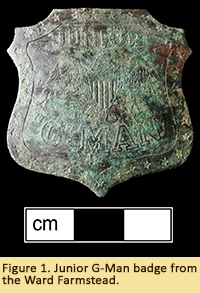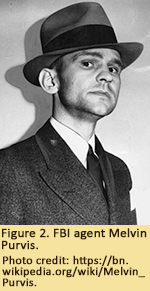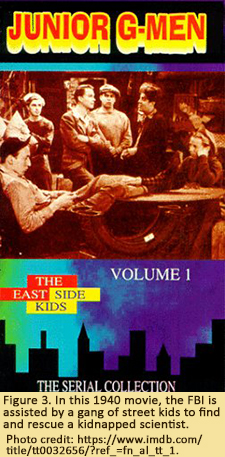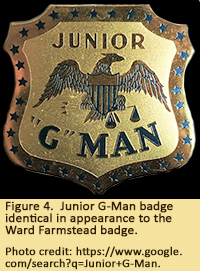Curator's Choice 2018
The Junior G-Man Badge
November 2018
By Gareth Mcnair-Lewis, Conservation Technician
 Junior G-Man was an American boys club begun in the late 1930s and was based on a children's radio show hosted by former Federal Bureau of Investigation agent Melvin Purvis. Purvis was best known for bringing the gangster John Dillinger to justice. The real exploits of Purvis and his fellow agents replaced fictional detectives such as Dick Tracy, capturing the imagination of adults and children alike (Wikipedia 2018a).
Junior G-Man was an American boys club begun in the late 1930s and was based on a children's radio show hosted by former Federal Bureau of Investigation agent Melvin Purvis. Purvis was best known for bringing the gangster John Dillinger to justice. The real exploits of Purvis and his fellow agents replaced fictional detectives such as Dick Tracy, capturing the imagination of adults and children alike (Wikipedia 2018a).
 Junior G-Man was promoted and popularized by FBI director J. Edgar Hoover. The public’s great interest in law enforcement and gangster movies, as well as Purvis’s fame and success, led to Junior G-Man clubs being formed all over the United States and Canada (Wikipedia 2018a).
Junior G-Man was promoted and popularized by FBI director J. Edgar Hoover. The public’s great interest in law enforcement and gangster movies, as well as Purvis’s fame and success, led to Junior G-Man clubs being formed all over the United States and Canada (Wikipedia 2018a).
The radio program allowed the listeners to join a "Junior G-Man" club and receive a wide variety of toy badges and secret agent items such as fingerprint kits, handcuffs and modern weaponry. Young boys who embraced the G-Man craze saw themselves as "detectives" rather than the ordinary "beat" cops. In fact, the name Junior G-Man was the term given to a new or young FBI agent or law enforcement officer of the Federal Government. The G was short for Government Man, an American slang term for special agents of the United States Government (Wikipedia 2018b).
 Melvin Purvis also became the face of the detective club promoted by the breakfast cereal Post Toasties. As young crime stoppers, kids could send in cereal box tops in exchange for codes, passwords, cap pistols, secret operators manuals and, of course, badges. In the mid-1930s Junior G-Man clubs quickly became very popular. Even police departments saw this phenomenon as a means of fighting against the high juvenile delinquency of the times. Movies, books, comic strips and numerous radio programs encouraged children to aid and embrace this "war on crime." Junior G-Man badges were numerous and varied in appearance. Some had symbols of authority. Some proclaimed "Roving Operative", "Secret Operator" or "Law and Order Patrol".
Melvin Purvis also became the face of the detective club promoted by the breakfast cereal Post Toasties. As young crime stoppers, kids could send in cereal box tops in exchange for codes, passwords, cap pistols, secret operators manuals and, of course, badges. In the mid-1930s Junior G-Man clubs quickly became very popular. Even police departments saw this phenomenon as a means of fighting against the high juvenile delinquency of the times. Movies, books, comic strips and numerous radio programs encouraged children to aid and embrace this "war on crime." Junior G-Man badges were numerous and varied in appearance. Some had symbols of authority. Some proclaimed "Roving Operative", "Secret Operator" or "Law and Order Patrol".
 This particular Junior G-Man badge, probably owned by a young boy, was found at the Ward Farmstead site in Baltimore County. It was a farm that was occupied from the late 19th until the late 20th centuries. The badge was in quite a corroded condition. Nevertheless, most of the thirty-two stars on the outer rim are visible as well as the words "Junior G-Man", the left looking eagle with its shield and talons holding three arrows and the scales of justice. Many varieties of the badges were produced; quite a few with the name of Melvin Purvis prominently displayed.
This particular Junior G-Man badge, probably owned by a young boy, was found at the Ward Farmstead site in Baltimore County. It was a farm that was occupied from the late 19th until the late 20th centuries. The badge was in quite a corroded condition. Nevertheless, most of the thirty-two stars on the outer rim are visible as well as the words "Junior G-Man", the left looking eagle with its shield and talons holding three arrows and the scales of justice. Many varieties of the badges were produced; quite a few with the name of Melvin Purvis prominently displayed.
Children's clubs like Junior G-Man validated children to be real world achievers and to participate in daring adventures. Among the many clubs of this period the Junior G-Man club certainly fulfilled just that role (Jacobson:2004).
References